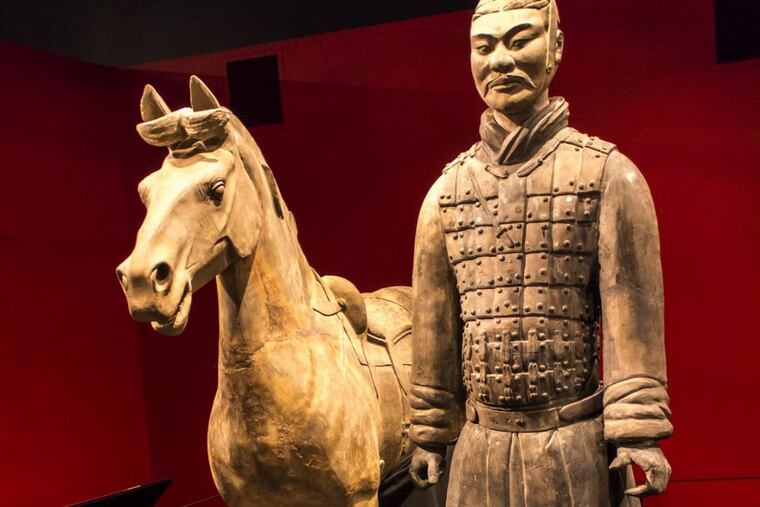Franklin Institute partygoer who stole a finger from a Chinese warrior statue pleads guilty
The admission of guilt from Michael Rohana, 29, comes nearly six years after the act of vandalism, which sparked an international incident with China and a trial that confounded the art world.

A Delaware man who confessed to drunkenly snapping a finger off an ancient Chinese terra-cotta warrior statue at the Franklin Institute pleaded guilty Monday to a federal misdemeanor charge that could send him to prison for up to a year.
The guilty plea from Michael Rohana, 29, of Bear, Del., came more than five years after his prank at the museum’s 2017 ugly sweater Christmas party sparked an international incident with China, exposed Pennsylvania’s most popular museum to questions about its security failures and eventually landed Rohana at the center of a case that confounded the art world.
A jury failed to reach a verdict during a previous trial, hung up on whether the value of the digit Rohana damaged exceeded $5,000 — the threshold for the felony charge he originally faced.
As part of the deal with prosecutors cemented in court Monday, both sides acknowledged the value of the filched finger was less than $500 — slashing the punishment Rohana will face at his sentencing this summer by more than a decade.
Despite that concession, Assistant U.S. Attorney K.T. Newton said after Monday’s proceedings that prosecutors still maintained Rohana had caused incalculable damage to a priceless artifact central to Chinese history. She explained the plea deal by saying the government was mindful of court time and resources while still satisfied that justice was being carried out in the case.
» READ MORE: How a stolen thumb and drunken mistake at a Philly museum confounded the international art world
The statue — a life-size figure known as The Calvaryman, insured at $4.5 million — is one of the few fully restored terra-cotta figures of the thousands recovered in fragments from the tomb of China’s first emperor, Qin Shi Huang, who united the nation under his rule in the third century B.C.
The Chinese government strictly regulates display and restoration of the 2,000-year-old relics and had spent years reviewing the Franklin Institute’s security protocols and exhibit plans before choosing it in 2017 as one of two U.S. museums to host a traveling exhibit of the statues recovered from the emperor’s tomb.
That exhibition, between September of that year and March 2018, coincided with one of the institute’s periodic “Science After-Hours” events, programs aimed at attracting adults and often featuring themed activities and alcohol sales.
Rohana — dressed in a fuzzy green sweater and a Phillies cap — drove in with friends from Delaware for one such event, a holiday-themed party during which he stole away from the festivities to explore.
Security footage showed him skulking past a roped-off stanchion, up a ramp and into the darkened room that housed the closed terra-cotta warrior exhibit. He snapped selfies, mugging for the camera while he grabbed one of the statues in a side embrace.
Before sneaking back out, he paused to examine one more — The Cavalryman — reached out to touch it’s hand, grasped its left thumb and pulled.
Testifying during his trial in 2019, Rohana told jurors he panicked after it snapped off in his hands. He shoved it in his jeans pocket and left, later hiding it in a desk drawer in his parents’ home, where he still lives.
But when FBI agents showed up at his home weeks later — after identifying him from that security footage — Rohana immediately confessed.
“I don’t know why I broke it,” he told the jury. “It didn’t just happen, but there was never a thought of, ‘I should break this.’ ”
Prosecutors initially charged Rohana under the federal art theft statute, a law that requires the items in question be worth more than $5,000 and is more commonly used to prosecute perpetrators of museum heists.
His case marked the first time the statute had been applied to a theft where the motive was not financial gain but the sheer thrill of vandalism.
Rohana’s lawyers — public defenders Catherine C. Henry and Nancy MacEoin — balked at what they described as a case of prosecutorial overreach.
“These charges were made for art thieves — think like Ocean’s Eleven or Mission: Impossible,” Henry said in her closing argument during the trial. Rohana “wasn’t in ninja clothing sneaking around the museum. He was a drunk kid in a bright green ugly Christmas sweater.”
In the end, jurors said they were confused by conflicting testimony over the value of the broken thumb from dueling art appraisers testifying for the government and the defense, and they were unable to agree whether the thumb met the $5,000 threshold to constitute a felony crime.
The onset of the coronavirus pandemic delayed a retrial in Rohana’s case by years as many of the witnesses the government had called to testify about the statue’s history and significance had to be flown in from China.
His guilty plea to one misdemeanor count of trafficking in archaeological resources — a charge much closer to what his attorneys had previously argued was appropriate in his case — negates the need for a second trial.
As he did for much of his first trial, Rohana said little in court Monday as he sat between his lawyers at the defense table answering questions from U.S. District Judge Chad F. Kenney as his family sat behind him in the courtroom gallery.
They and Rohana declined to comment after the proceedings concluded.
He will return to court to face sentencing on Aug. 17.